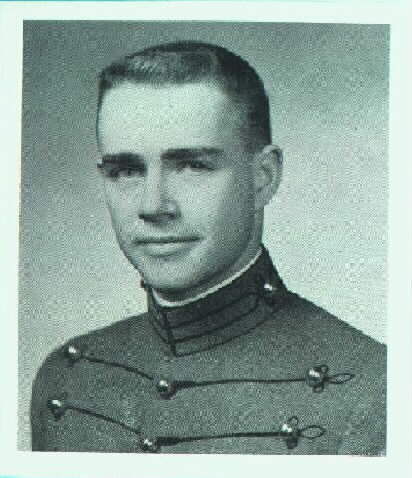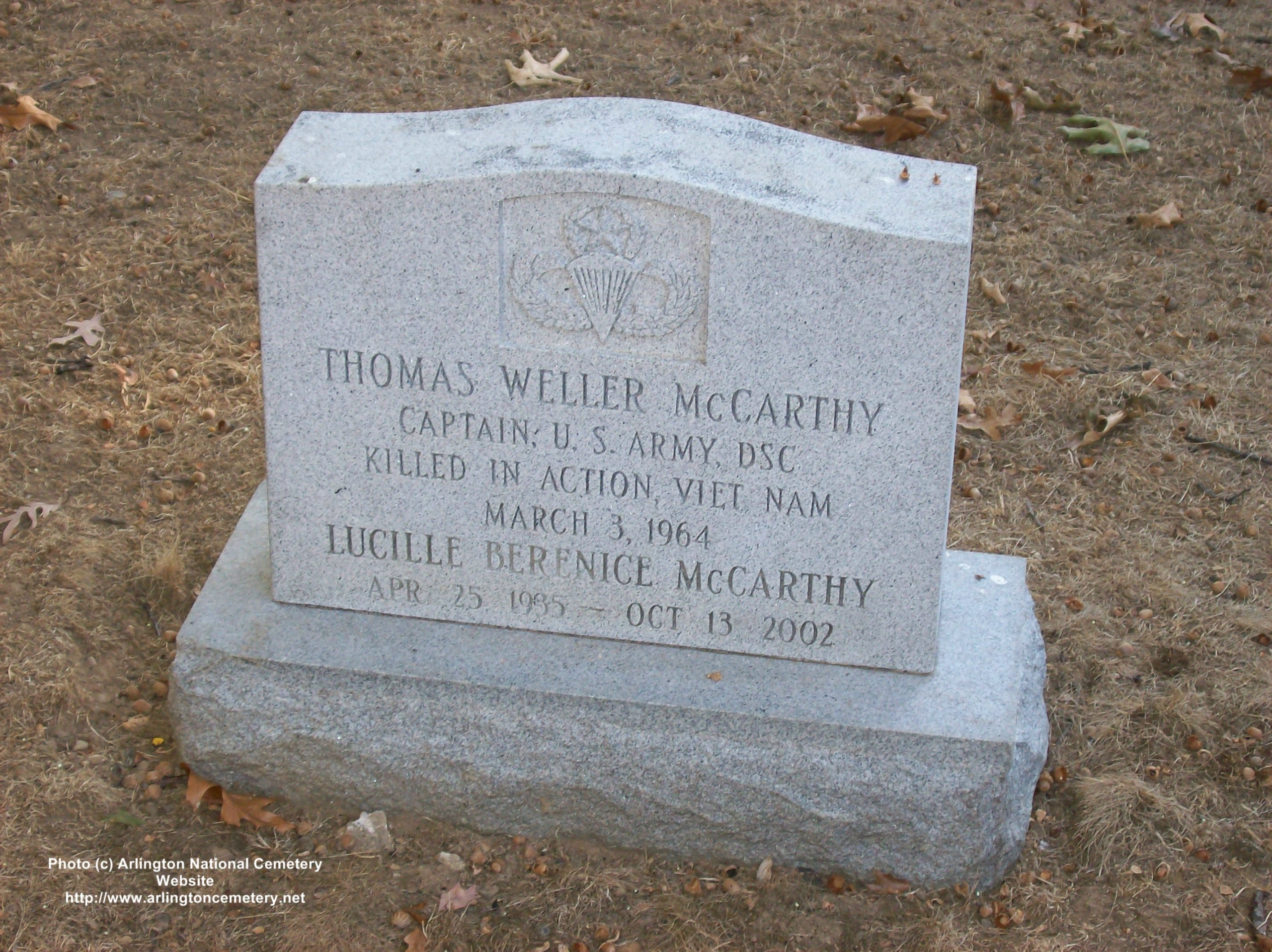An “Army Brat,” the son of an Army Colonel, he was born in the Philippines where his father was serving.
He graduated from West Point in 1955 and was assigned to Fort Bragg, North Carolina, with the 82nd Airborne Division.
He was killed-in-action in the Republic of Vietnam on March 3, 1964 in action against the Viet Cong near the Cambodian border. He received the Distinguished Service Cross, posthumously, for the gallantry he displayed and for the way in which he exemplified the “highest traditions of the United States Army.” Perhaps what would have pleased him the most was what a Vietnamese General who commanded the Airborne Forces said: “In the confusion that followed the initial outburst of fire, part of the company started to break up. He was immediately among them, rallying them together. If we hadn’t charged, we would have been annihilated – and McCarthy was right up there with me. He was the bravest soldier I ever knew.”
He was buried with full military honors in Section 1, Arlington National Cemetery.
NOTE: The Captain’s father and mother were Charles Weller McCarthy and Charlotte Piekenbrock McCarthy. His brother, John Michael McCarthy, Lieuenant Colonel, and also a graduate of West Point, also lies at rest in Arlington National Cemetery.
U.S. Military Academy Photo Courtesy of Colonel Robert P. Johnson, United States Army, a Classmate of McCarthy’s who wrote:
We had a small ceremony on 15 May 1999 at Arlington for Tom McCarthy. Found the gravesite with little trouble. We broke out a bottle of Irish Whisky and drank a toast and one of his former roommates filled an extra shot glass and poured it on his grave.
The Text from the USMA Yearbook reads:
Thomas Weller McCarthy
Chevy Chase, Maryland
Congresssional I-2
Tom, an army brat, came to West Point from Chevy Chase, bringing along his sparkling personality and versatile ability as a gymnast. For a professed goat, he coasted to a high class standing with little study and much sack time. With such a background it is inevitable that Tom will always come out on top.
Gymnastics 4-3-2-1, Numerals, Minor “A”; Catholic Acolyte 3-2-1; Catholic Choir 4-3-2; Fishing Club 4-2-1; Skeet Club 4-3-2-1; Forum 2-1; Corporal; Lieutenant 1.
Remembrance by a classmate from West Point:
Courtesy of Will Holbrook <[email protected]>)
Thomas Weller McCarthy
No. 20531 – Class of 1955
Hostile death, Vietnam 3 March 1964, aged 30 years.
Internment: Arlington National Cemetery
So moved they calmly to the field,
Thence never to return,
Save bearing back the Spartan shield,
Or on it proudly borne.
Felicia Dorothea Hemans ( 1793-1835 )
On the 3d of March 1964, in the Republic of Vietnam, a young senior advisor to 1st Vietnamese Airborne Battalion who had imbued the spirit of these lines from The Spartans’ March into his unit was, on this day, himself sadly but proudly, borne from the field of battle. His shield was a strong faith in God, a courage born in him as a soldier’s son, and a determination to fight for and protect what he believed in. Such was the destiny of Thomas Weller McCarthy who lived as a soldier and died as a soldier.
Tom was born in the post hospital at Fort John Hay near Baguio in the mountains of Luzan on 30 April 1933. The camp, which had been designated as a rest center, was located in a pleasant mountain retreat where U.S. military personnel assigned in the Philippines could escape from the low land heat. The family lived there while Tom’s dad was assigned to one of the two Igorote companies of the 45th Infantry (Philippine Scouts).
Tom’s early years were spent in a number of locations, including Washington, D.C., during World War II, and Chile, from 1947 to 1950. In Chile, Tom was enrolled in St. George’s College where the entire curriculum, except for America history, was taught in Spanish. The first six months were understandably difficult, but Tom quickly developed a working knowledge of the language and actually became quite fluent in it before the end of his dad’s three year tour. The family returned to Washington in 1950, and Tom, aged 17, was enrolled in Sullivan’s Prep with West point as his goal.
After the usual struggle for an appointment, he entered in July 1951 with the class of 1955. As a cadet, Tom continued to develop the inborn qualities of moral courage and physical stamina that were to serve him so well throughout his short career, and to create lasting impressions of greatness on all who came in contact with him. He participated in many extracurricular activities including the Catholic Chapel choir and the gymnastics team, and he was well known among his classmates for his keen wit, quick laugh and rare sense of humor.
Tom was commissioned a second lieutenant of Infantry on 3 June 1955, and after completing the Basic Infantry Officer Course, began his airborne training. This last was to become an intrinsic part of his life. Tom’s first duty assignment was with the 82d Airborne Division at Fort Bragg, North Carolina. He was to serve almost half his active service with this division. In 1958 Tom went to Germany for duty with the 24th infantry division, was in Lebanon during the 1958 crisis, and returned in 1960 to the United States.
While in Germany, Tom met Lucille Berenice White, and upon his return to the States they were married at Fort Benning on 23 April 1960. Tom commanded Company C, 325th Airborne Battle Group, 82d Airborne Division at Fort Bragg from June 1961 to June 1962 at which time he joined Headquarters, XVIII Airborne Corps as Secretary of the General Staff.
In May 1963, Tom, in the tradition of many West Pointers before him, traveled half-way around the world to protect his own country and to assist an ally in need. He was assigned as senior advisor to the 1st Airborne Battalion of the Airborne Brigade. These were South Vietnam’s “elite” troops, the trouble-shooters who were called upon when things got rough.
On the 2d of March 1964, this battalion set out from its home station at Ton Son Nhut Air Base towards the flat valley of the Mekong River in Kien Phong province about 90 miles west of Saigon, a little more than a mile from the border of Cambodia. Early next morning Tom’s and another battalion continued to advance on their assigned objectives. Without warning, entrenched Viet Cong regulars opened fire from three sides on the two advancing battalions, using automatic weapons, mortars and recoilless rifles. When part of the Vietnamese unit began to falter, Tom unhesitatingly began to rally them and to urge them forward. After advancing across 75 yards of open ground, Tom was felled, mortally wounded. But as a result of his heroic actions, the Vietnamese troops continued to press forward forcing the VC to withdraw across the Cambodian border.
Captain Charles R. Johnson, a classmate serving with Tom in Vietnam, escorted his body back to the United States. He was buried with full military honors in Arlington National Cemetery on 11 march 1964, just two months prior to his scheduled return to the States for attendance at the Command and General Staff College.
Eulogies and letters of condolence from many of Tom’s friends helped to relieve the deep sorrow suffered by Berenice and their three sons, Thomas Gerard, 3, Robert Weller, 2, and John Martin who was born after Tom left for Vietnam.
At Ton Son Nhut Air Base, Tom’s Vietnamese unit and his U.S. contemporaries paid farewell homage to Tom at a plane-side ceremony. A grateful Vietnamese government also made the posthumous award of the its Medal of Honor, first class, the highest decoration which could be presented to an American.
Tom was the first member of the Class of 1955 to become a casualty of the Vietnamese War. For his heroism he was awarded the Distinguished Service Cross, his own nation’s second highest award for bravery. It was the first award of this decoration to an Academy graduate in the Vietnam action. Berenice accepted the award at ceremonies at Fort Bragg, North Carolina on 19 June 1964. Part of the accompanying citation reads:
As casualties mounted rapidly and the friendly troops were thrown into confusion, Captain McCarthy displayed complete disregard for his own personal safety and unhesitatingly moved into the inferno of hostile gun fire to organize the troops and establish an effective base of operations. He then joined his counterpart with the lead element and continued his brave efforts to rally encourage the troops until he was mortally wounded.
A indication of the impact that Tom’s leadership left on the men he commanded was the request by every man in the 82d Division who had served under him to attend his funeral at Arlington where they could pay their last personal tribute to him.
As a monument to Tom’s memory, an amphitheater at the corner of Gruber Road and Bastogne Drive, Fort Bragg, North Carolina, has been named in his honor. The Infantry School at Fort Benning also has honored him by naming the parachute training building at Lawton Field “McCarthy Hall”.
Generals and soldiers alike were outspoken in their praise of Tom. Their feelings can best be summed up in the words of Major General Robert H. York, Commanding General of the 82d Airborne Division, when he presented the Distinguished Service Cross to Tom’s widow.
If the measure of a man’s life can be based on the respect and esteem he has gained among his associates, seniors, subordinates, and peers, or on the contribution he makes to his country, rather than on a span of years, then Captain McCarthy lived a full and rich life.
It was a fitting tribute and to it I add this final salute to a gallant soldier and a dear friend.
Michael Robert Patterson was born in Arlington and is the son of a former officer of the US Army. So it was no wonder that sooner or later his interests drew him to American history and especially to American military history. Many of his articles can be found on renowned portals like the New York Times, Washingtonpost or Wikipedia.
Reviewed by: Michael Howard



